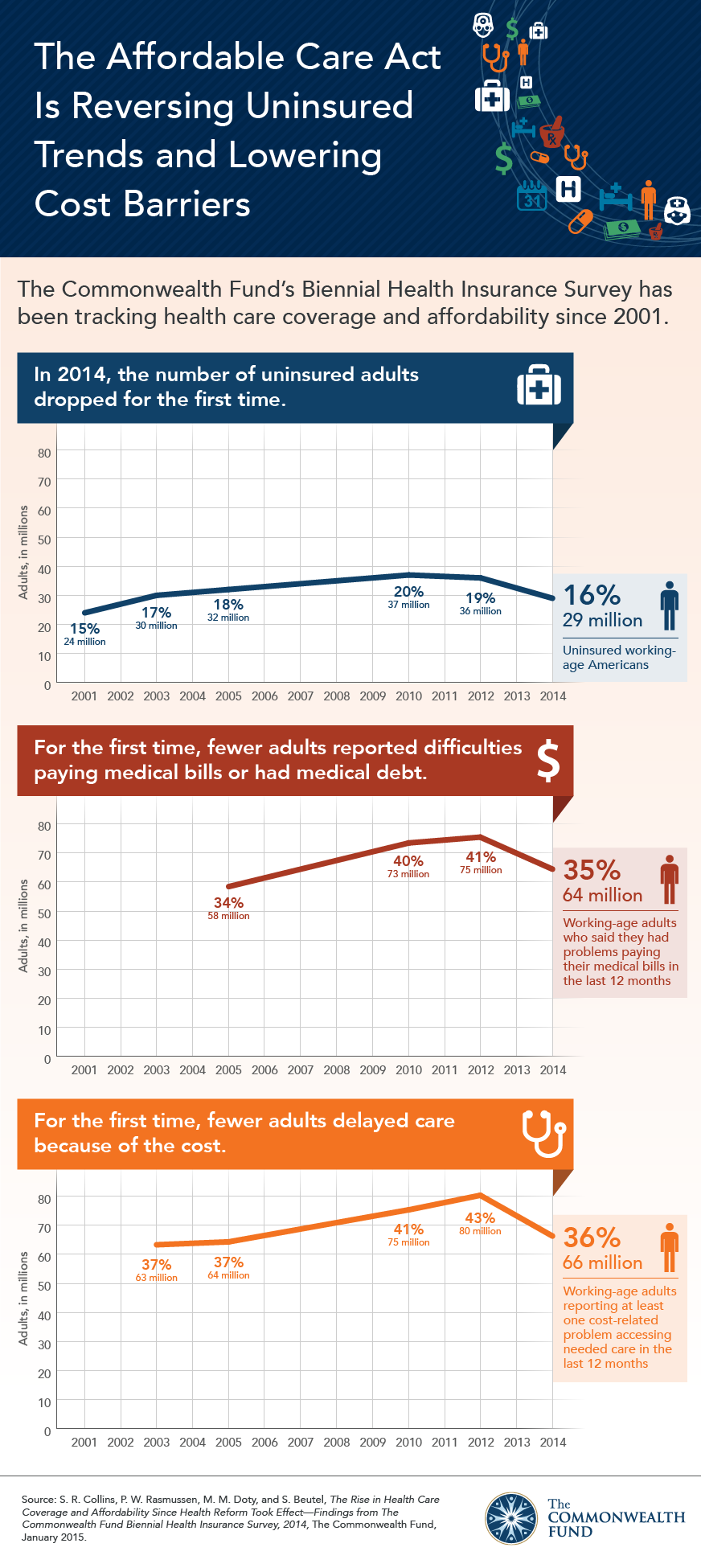Rise in Health Care Coverage and Affordablity








A 2015 report from the Commonwealth Fund shows a rise in health care coverage and affordability since ObamaCare was enacted.
The report highlights three areas where ObamaCare (the Affordable Care Act) is curbing costs and improving healthcare – Coverage, Medical Debt, and Access to Care.
Commonwealth fund is the longest running non-Federal health survey. While the report is based on survey data (not actual totals from the US), what it shows is that the ACA has curbed trends in consumers not being able to afford health care related costs. Many times the 2014 numbers (the report doesn’t include 2015 numbers) are the lowest or on par with 2001 numbers.
Due to the “health care crisis” the ACA was created to address unaffordability in regards to care and the uninsured rate was on a steep incline moving into 2009. The ACA contains a number of measures to protect consumers from medical debt including cost sharing limits for all plans post 2014, and the elimination of dollar limits on essential care. The ACA also includes cost assistance for middle-to-low income adults and further assistance programs for young people and working adults with low incomes.
Especially for low-income adults and young people, cost related problems have been curbed drastically. Read a summary of the report, or check out the full report below. Remember all surveys use their own data and own methodology, so that should be taken into account when comparing uninsured rates in this report to other uninsured reports.
New results from the Commonwealth Fund Biennial Health Insurance Survey, 2014, indicate that the Affordable Care Act’s subsidized insurance options and consumer protections reduced the number of uninsured working-age adults from an estimated 37 million people, or 20 percent of the population, in 2010 to 29 million, or 16 percent, by the second half of 2014. Conducted from July to December 2014, for the first time since it began in 2001, the survey finds declines in the number of people who report cost-related access problems and medical-related financial difficulties. The number of adults who did not get needed health care because of cost declined from 80 million people, or 43 percent, in 2012 to 66 million, or 36 percent, in 2014. The number of adults who reported problems paying their medical bills declined from an estimated 75 million people in 2012 to 64 million people in 2014.
View the interactive map.
Read the brief – The Rise in Health Care Coverage and Affordability Since Health Reform Took Effect. Findings from the Commonwealth Fund Biennial Health Insurance Survey, 2014.

Vince Sauve
The ACA doesn’t help my wife and I at all. Our gross income is just over the limit of getting any subsidy. And her income doesn’t really help here at home anyway since she sends much of it to her family in Peru.
If I were to get the kind of coverage for the both of us that I used to have before I retired, a so-called Cadillac plan, with no deductible, it would take away more than one quarter of my income and most of my disposable income. I very much dislike the the deductible plans.
We are opting to go without any medical coverage and instead get extensive care when we visit my wife’s sister in Peru. We can use a clinic and pay cash when we need to here in the USA. The price transparency and price difference between getting medical care in Peru versus getting care in a hospital in the USA is vastly different. Four months ago I had surgery in Peru (a fine and successful experience) for a procedure that would have costs many thousands–maybe tens of thousands–if done here. In Peru they got me a maximum price quote in less than an hour and surgery was done less than a week later. Surgery and a hospital room and a visit to three professionals cost me a total of slightly less than $700.00 (seven-hundred) This price was less than the maximum they said it might cost. Compare this with the sneaky billing practices American hospitals sometimes do.
American medical care is just insanely expensive and the “Affordable” Care Act is misnamed in my opinion. America needs to learn from other countries.
ObamaCareFacts.comThe Author
Thank you for sharing that story. The underlying cost of healthcare is the sticking point that we have to deal with in America. But for today it is what it is and most Americans aren’t going to simply go over to Peru to get care (especially not in an emergency). That is why it’s important that people can get non-cadillac plans at affordable costs. The “affordable” part refers to Marketplace cost assistance, limits on cost sharing, expansion of Medicaid, improvement of Medicare (think closing of the donut hole), cost curbing measures to bring down health care costs, and the limits on what sick people and women can be charged and charged for. It is not a term that means everyone gets cheaper care, or that all care is affordable.